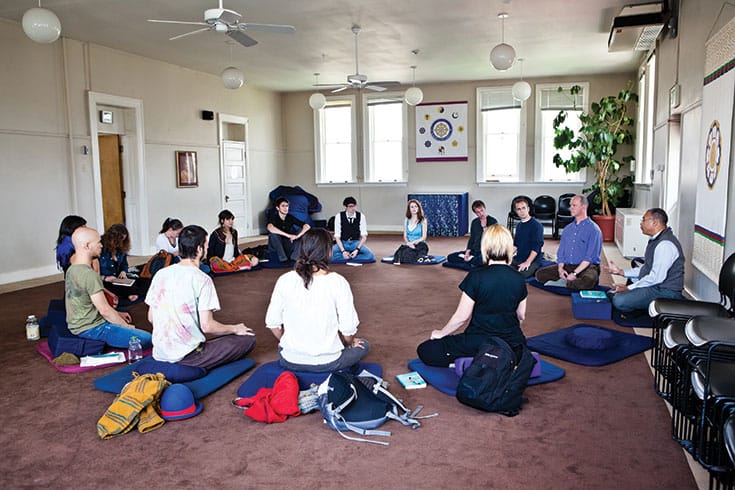In his first teaching at Deer Park, the Buddha praised mindfulness: “The Noble Eightfold Path is nourished by living mindfully.”
From the beginning, the path of awakening includes all aspects of our human lives: physical, emotional, mental, spiritual, and social. The aim is a mindful life. This means that our relationship to our sexuality and our consumerist economic system, our parenting, and our politics are all part of the path.
This approach to living fully is outlined in the eightfold path. “Right mindfulness” is one aspect of this path, alongside right view, right intention, right effort, right meditative engagement, right speech, right livelihood, and right action. The Sanskrit word samyak—often translated as “right” or “perfect”—can also mean “complete.” Engaging mindfulness encourages complete engagement with life.
Let’s walk through these aspects of the Buddhist spiritual path, returning mindfulness to her rightful place among her seven less famous but equally important sisters and brothers.
Right View
The central view of the Buddha’s teaching is a middle way, avoiding the extremes of aggressive asceticism (being harsh with ourselves and others) and laissez-faire indulgence (spiritual laziness). We approach all our experience with basic friendliness and respect. In the context of meditation practice, this means gently placing awareness on our bodies and minds in a “not too tight, not too loose” manner. Without this view of fundamental loving-kindness, there is no mindfulness meditation. Practicing mindfulness as mere mental gymnastics leaves us feeling even more depleted.
Experience is the heart of the matter, but we need first to understand what we are doing, why we are doing it, and how mindfulness relates to the rest of our lives.
In a culture where “Just do it” now has the well-worn familiarity of a mantra, jumping into mindfulness practice without first contemplating the view seems an attractive option. Why study the classic teachings on meditation when the main point is to practice? Isn’t the whole point not to think too much about it? But the Buddha wisely suggested study and contemplation as supports to any practice. Yes, experience is the heart of the matter, but we need first to understand what we are doing, why we are doing it, and how mindfulness relates to the rest of our lives.
Right Intention
Why are we engaging in mindfulness? Contemplating our intention at the beginning of a session rouses our motivation. Our aim may be calmness or peace, stability or a more compassionate heart, or all of the above. The point is that we have already entered the session with some sense of purpose or direction. Take a moment for self-reflection and nonjudgmental self-awareness before rushing on. This gesture of self-respect can gently cut some of the momentum of our accumulated neurotic speed.
Acknowledging the motivation we already have can be the first step in an expanding journey. The stress and anxiety we sometimes feel are surely shared by others around us—in our families, our workplaces, our communities. Including a sense of practicing for their well-being and liberation is called “the great motivation.” We are walking a path of awakening that includes being generous and caring, patient and helpful. This expansiveness of intention brings spaciousness and warmth to our sitting practice, allowing those heartfelt qualities to pervade our daily living with others.
Right Effort
Effort also has an associated slogan in contemporary culture: “No pain, no gain.” If we don’t try and try again and try harder, we are told, no result can be attained.
This can lead to a one-sided approach to exertion, as though the Buddha’s meditation instruction was to place the attention “not too loosely, not too loosely.” We can find ourselves practicing with hypervigilance, eager participants in a new spiritual sport called Extreme Effort. Meditators can develop a habitual tightness instead of cultivating the relaxed spaciousness of heart and mind that originally inspired us toward awakening.
My first Buddhist meditation teacher, Chögyam Trungpa Rinpoche, spoke of non-effort as a worthy partner to effort: “Effort, non-effort and effort, non-effort—it’s beautiful.”
Mindfulness is an innate capacity, present in all sentient beings.
Yes, it is important to apply ourselves, to engage fully in mindful living. But it is equally important to release all trying and confidently trust our innate mindfulness to shine through. All the Buddhist traditions of natural wakefulness, original goodness, or buddhanature are based on this sense of inborn wisdom not produced by meditating or walking the path. This is the practice of basic sanity through what is called “just sitting” or “non-meditation” or “primordial great perfection.” As the pioneering Zen master Shunryu Suzuki Roshi phrased it: “The point we emphasize is strong confidence in our original nature.”
In this view, mindfulness is not a special attainment or an extraordinary event in our life journey. Mindfulness is an innate capacity, present in all sentient beings. Walking the path, we are gently cultivating our own nature, allowing seeds of potential to blossom. From this perspective, awakening is as natural as the dawning of the sun. We are invited to begin each session by feeling this naturally awake quality—and to return to this original openness again and again during practice and everyday life.
Right Meditative Engagement

The Sanskrit word samadhi is often translated as “meditative absorption,” but this can suggest being so absorbed in something (such as a favorite piece of music) that we are oblivious to everything around us.
If we engage our bodies and minds and breathing and emotions fully in mindfulness practice, on the other hand, that same quality of spacious connection can continue as we rise from meditation. Mindfulness goes hand in hand with noticing the environment around our body, around our breathing, around our thoughts and emotions. We listen to what our partner is saying rather than mentally replay the tense moments from our day at work. We notice the swaying of the trees in the wind, just as we notice the movement of our legs in walking meditation. Same directness, same inclusiveness.
Right Speech
From mindful listening can arise mindful speaking. Here non-effort may provide another helpful hint: leaving pauses in our speech allows for genuine dialogue. Slowing down the impulsive momentum of saying one thing after another is a natural result of mindfulness. Mindful communication is the basis of mindful communities.
Mindless speech is speech that causes harm through gossip, slander, lying, and deception. The result of such speech—as when politicians play on our fears to incite hatred—is a divided society; we feel more disconnected from each other. Mindful speech is acting to heal societal wounds.
Right Livelihood
Mindfulness brings a sense of well-being, an inner richness we share with others by our work in a kindergarten or hospice, corporate offices or a bank. The ordinary meaning of “livelihood” connects it with surviving—the way we earn money in order to live. Right livelihood lifts our gaze from the simple mechanics of survival. Our work is the way we contribute to the common good. Livelihood is our offering, an act of generosity. We are called—the root meaning of “vocation”—to serve and inspire, to propagate healthiness and sanity in myriad ways.
Right Action
Meditation in action is the natural expression of mindfulness. These steps on the path of awakening remind us that the proof of our practice is in the pudding of daily life. The whole purpose of this training, it has been said, is to manifest. Sitting still and radiating compassion are useful first steps, but now the old slogan is reborn amid the urgent necessity for compassionate activity to meet the challenges of climate change, increasing social inequality, and disintegrating societies based on fear: “Don’t just sit there, do something!”
Let’s conclude our contemplative walk by returning to where we began: the Buddha. The practice of mindfulness meditation and the teaching of the eightfold path have been handed down to us in human lineages of transmission beginning with the Awakened One. Thus, the Buddha stands as original ancestor as well as embodiment of the teacher principle. Living human teachers—sometimes called “spiritual friends”—remind us of the necessarily expansive quality of walking the path. We all have habitual blind spots, and so we contract from time to time into our own narrow versions of the path of awakening. Spiritual friends encourage and provoke and challenge us to engage mindfulness as a step toward a completely awakened life.

